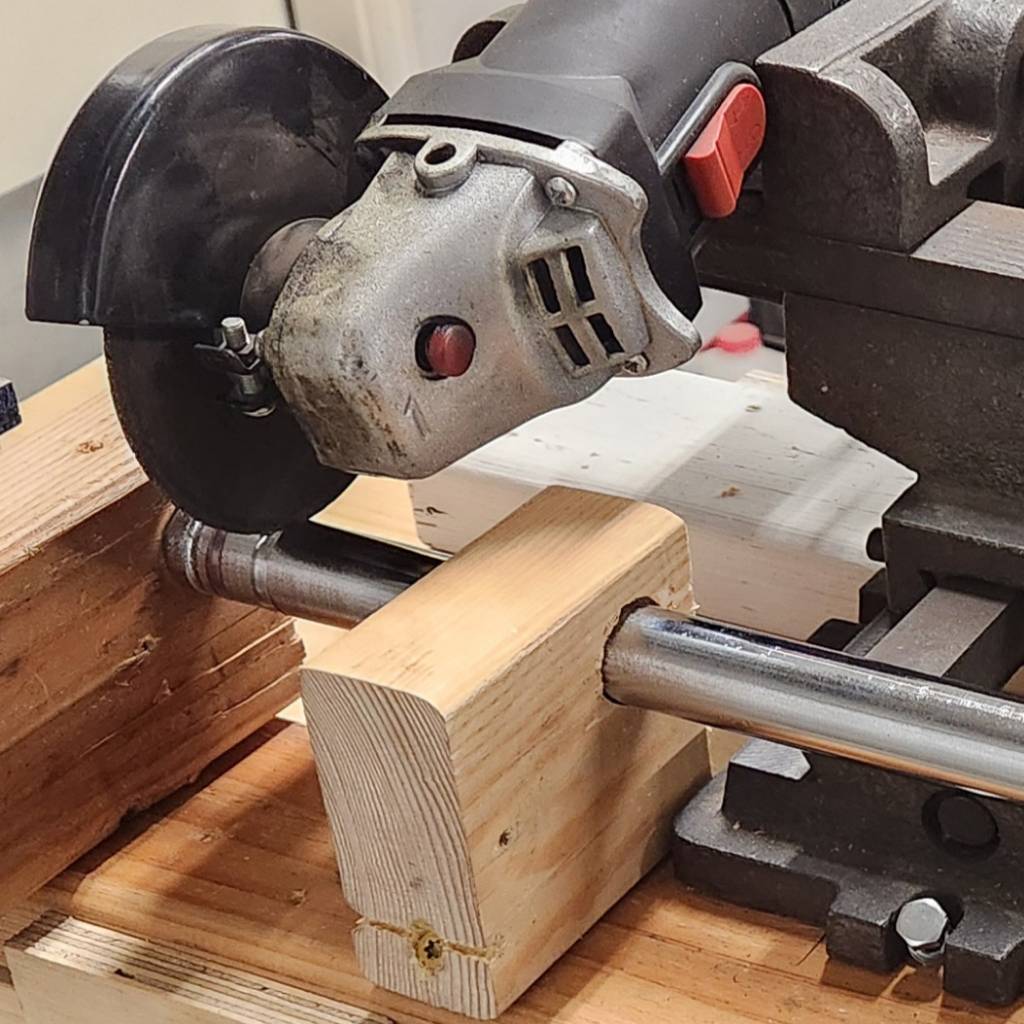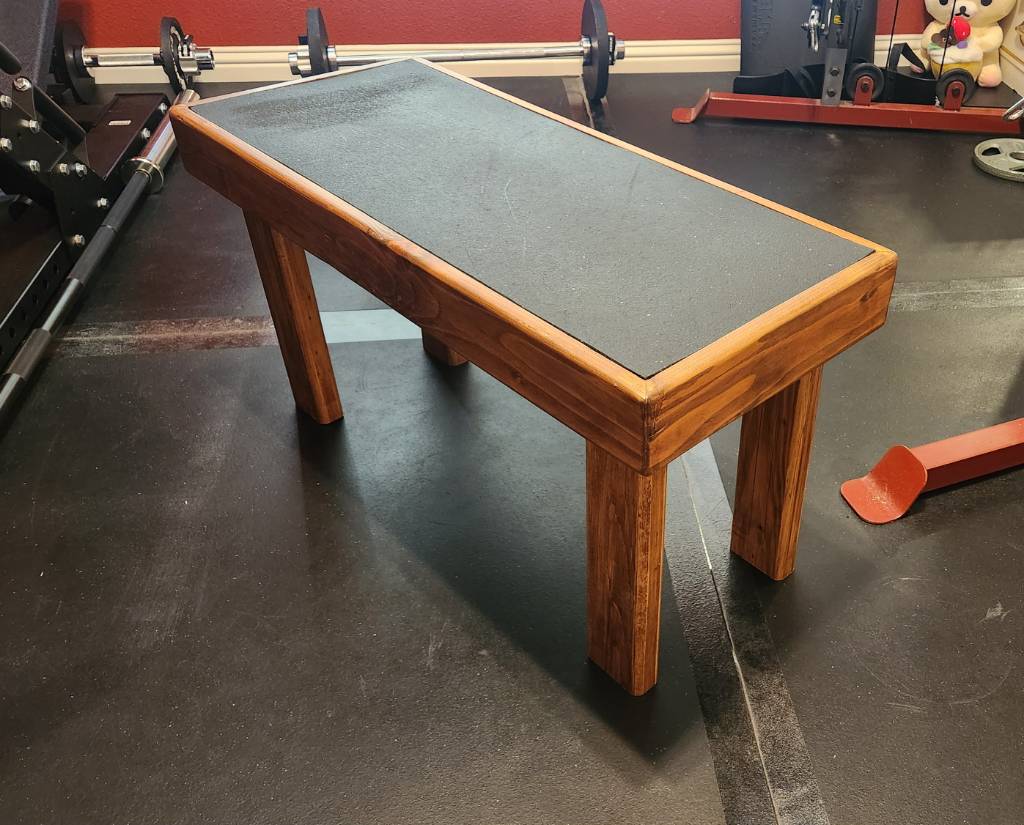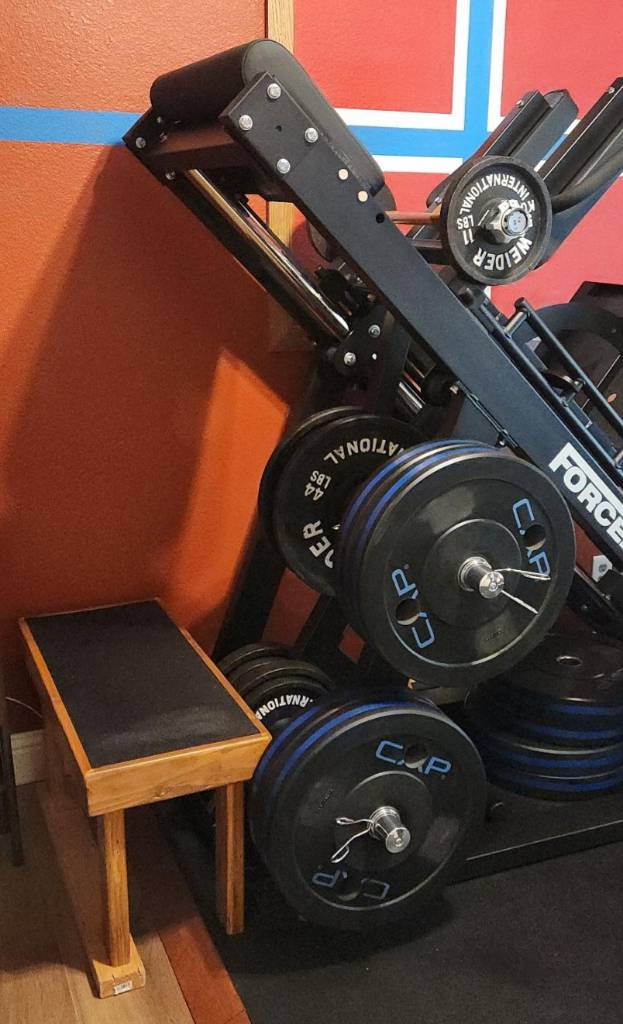This is the story of how I turned a 15" Titan adjustable dumbbell to be 80 cm (31.5 inch) long. Why? Because I have a space-constrained home gym but still wanted a leg press, and so I had to remove its original barbell.
In its place, I built a pair of wood mounts for a normal barbell to rest upon, covered in that earlier post. However, since this machine is wall-adjacent, such a barbell would have to fit inside the width of the leg press, so about 80 cm. But must also be wider than the spacing from outside-edge to outside-edge of the wood mounts, which is 60 cm.

Such a short barbell -- or long dumbbell -- does not readily exist commercially, with the narrowest one I've seen being 48 inch barbells, which are still too wide. So I decided to build my own, using my spare Titan dumbbell as the base.
To start, the Titan dumbbells are excellent in this capacity, as the shaft diameter is 28 mm -- not 32 mm as the website would indicate -- which is a common diameter, if I am to cut short a cheap barbell to replace this dumbbell's shaft.
In keeping with my preexisting frugality, I purchased a cheap 1-inch barbell, hoping that it adopts the Olympic 28 mm shaft diameter, and not the 29 mm deadlift bar shaft diameter, as the Titan collars have small clearances. Matching neither, I find that this bar is closer to 23 mm, which although will fit into the existing collars, poses its own issues.
Nevertheless, this 7 ft barbell can conveniently be cut in half to yield two 42 inch segments. And then the included bar stops can be loped off, and then the length further refined to 77 cm, thus hiding the marks from the bar stop within the Titan collars, and also centering the (meh) knurling from the cheap bar.
But perhaps a picture will be more explanatory. Here, the original collar is dismantled at the top, showing the original shaft with a groove cut into it, about 1/4-inch from the end. Into that groove would fit two half-rings with an inner diameter of 20.4 mm and an outer diameter of 40 mm. In fact, all the parts inside the collar use 40 mm outer diameter, except the spacer cylinder, which is smaller at 37 mm. All of these parts are held captive within the collar using the C-ring and the geometry of the collar itself.

To deal with the difference between the collar expecting 28 mm, and the cheap bar's 23 cm, I designed an ABS 3d printed part in FreeCAD to act as a bushing, upon which the original Titan brass bushing will ride upon. This ABS bushing is held captive by way of its center bulge, which fits within the dead space inside the collar.

As for how I cut the groove into the end of the new shaft, I still don't own a lathe. So the next best is to mount an angle grinder onto a "cross slide vise" taken from a drill press, with the shaft secured in a wooden jig to only allow axial rotation manually. The vise allows precision control for the cutting wheel's depth, with me pausing frequently to measure how close the groove is to the desired 20.4 mm inner diameter. This is.... not a quick nor precise process. But it definitely works.

After reassembling both collars onto the new shaft and lubricating with white lithium, the final result is a long dumbbell (or short barbell) with Titan's 3.5 inch collars on the end, with 63 cm of shaft exposed and 80 cm from end to end. The ABS bushing is remarkably smooth against the brass bushing, after some sanding with 180 grit. The whole dumbbell weights 5.48 kg empty.

Here is the comparison with the stock Titan dumbbell. It's pretty amazing how the knurling conveniently lined up. It fits well onto the wood mounts of the leg press.


But why would I do all this just to add a weirdly long 3.5-inch collar dumbbell to a leg press, when it already can accept weights underneath the carriage? I will answer that in a follow-up post.













I'll address your question in two parts: 1) is it redundant to store both the IP subnet and its subnet mask, and 2) why doesn't the router store only the bits necessary to make the routing decision.
Prior to the introduction of CIDR -- which came with the "slash" notation, like /8 for the 10.0.0.0 RFC1918 private IPv4 subnet range -- subnets would genuinely be any bit arrangement imaginable. The most sensible would be to have contiguous MSBit-justified subnet masks, such as 255.0.0.0. But the standard did not preclude using something unconventional like 255.0.0.1.
For those confused what a 255.0.0.1 subnet mask would do -- and to be clear, a lot of software might prove unable to handle this -- this is describing a subnet with 2^23 addresses, where the LSBit must match the IP subnet. So if your IP subnet was 10.0.0.0, then only even numbered addresses are part of that subnet. And if the IP subnet is 10.0.0.1, then that only covers odd numbered addresses.
Yes, that means two machines with addresses 10.69.3.3 and 10.69.3.4 aren't on the same subnet. This would not be allowed when using CIDR, as contiguous set bits are required with CIDR.
So in answer to the first question, CIDR imposed a stricter (and sensible) limit on valid IP subnet/mask combinations, so if CIDR cannot be assumed, then it would be required to store both of the IP subnet and the subnet mask, since mask bits might not be contiguous.
For all modern hardware in the last 15-20 years, CIDR subnets are basically assumed. So this is really a non-issue.
For the second question, the router does in-fact store only the necessary bits to match the routing table entry, at least for hardware appliances. Routers use what's known as a TCAM memory for routing tables, where the bitwise AND operation can be performed, but with a twist.
Suppose we're storing a route for 10.0.42.0/24. The subnet size indicates that the first 24 bits must match a prospective destination IP address. And the remaining 8 bits don't matter. TCAMs can store 1's and 0's, but also X's (aka "don't cares") which means those bits don't have to match. So in this case, the TCAM entry will mirror the route's first 24 bits, then populate the rest with X's. And this will precisely match the intended route.
As a practical matter then, the TCAM must still be as wide as the longest possible route, which is 32 bits for IPv4 and 128 bits for IPv6. Yes, I suppose some savings could be made if a CIDR-only TCAM could conserve the X bits, but this makes little difference in practice and it's generally easier to design the TCAM for max width anyway, even though non-CIDR isn't supported on most routing hardware anymore.